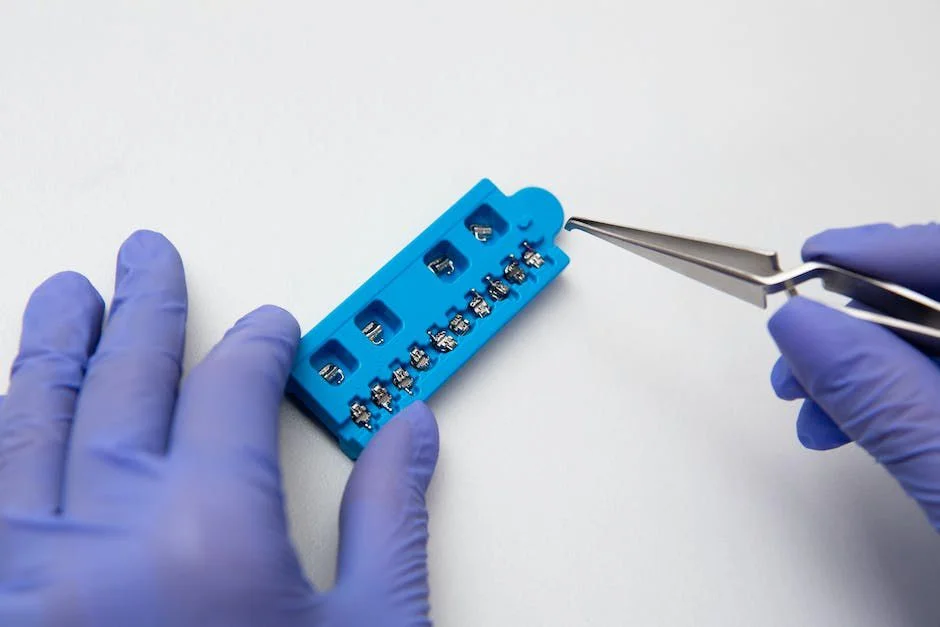Choosing braces can feel overwhelming. With so many options available, how do you know which one is the best fit for you? This guide will break down the different braces types, making it easier for you to decide.
Are you an adult looking for subtle options without a need for dental surgery or a parent researching for your child? Read on and you’ll find everything you need to know here.
Traditional Metal Braces
Traditional metal braces are the most common type of orthodontic braces treatment. They consist of metal brackets that are glued to each tooth and a metal wire that runs through them. This wire is periodically tightened by an orthodontist to gradually move your teeth into their correct positions over time.
Benefits of Metal Braces
One of the main benefits of metal braces is their durability. Metal braces are very strong and can handle most types of orthodontic treatment without breaking.
They are also the least expensive option compared to other types of braces. The materials used are robust and can correct severe orthodontic issues effectively.
Drawbacks of Metal Braces
However, metal braces are the most noticeable type of braces. If you’re concerned about aesthetics, this might not be the best choice for you.
They can also be uncomfortable, especially after adjustments when the wires are tightened. Additionally, they require careful cleaning to avoid food particles getting stuck and causing plaque buildup.
Ceramic Braces
Ceramic braces function like traditional metal braces but use clear or tooth-colored brackets instead of metal ones. This makes them less noticeable when worn, which can be a significant plus for adults and teens who are concerned about the appearance of metal braces.
Benefits of Ceramic Braces
The main advantage of ceramic braces is their appearance. They blend in with your teeth and are less obvious than metal braces, providing a more aesthetically pleasing option. They also work just as effectively as metal braces in most cases, allowing for the same range of treatment options and outcomes.
Drawbacks of Ceramic Braces
They are more expensive than metal braces and can be more fragile. The ceramic material can break more easily, which may require additional repairs. Ceramic braces can also stain if you don’t take care of them properly, so avoiding certain foods and drinks like coffee and wine is necessary to maintain their appearance.
Lingual Braces
Lingual braces are similar to traditional braces but with one key difference: they are attached to the back (lingual side) of your teeth, making them invisible from the front. This type of brace is custom-made for each patient to fit the contours of the backside of the teeth.
Benefits of Lingual Braces
These braces are perfect for those who want a discreet orthodontic treatment option. They provide the same results as traditional braces without the visible hardware. Lingual braces are ideal for individuals in public-facing professions or situations where aesthetics are particularly important.
Drawbacks of Lingual Braces
They are harder to clean due to their position, which can increase the risk of cavities and gum issues. Lingual braces may also cause more discomfort and speech difficulties initially as your tongue adjusts to the brackets. Additionally, they are more expensive and require a specialist for installation and adjustments, which can limit accessibility.
Invisalign
Invisalign uses a series of custom-made, clear, removable aligners to straighten your teeth. These aligners are made from a thermoplastic material specifically created for the Invisalign treatment and are designed by an Invisalign Orthodontist to fit snugly over your teeth.
Benefits of Invisalign
Invisalign aligners are almost invisible, making them a very discreet option. They can be removed for eating and cleaning, enhancing convenience and oral hygiene. This makes it easier to keep your regular diet and oral care routine. It avoids the restrictions of traditional braces.
Drawbacks of Invisalign
However, Invisalign is not suitable for severe orthodontic cases and can be costly. You also need to wear the aligners for 20-22 hours a day for them to be effective, which requires a high level of discipline and commitment. Regular follow-ups with your orthodontist are needed to monitor progress and provide new aligners.
Self-Ligating Braces
Self-ligating braces are similar to traditional braces but use clips or doors instead of elastic bands to hold the wire in place. These clips allow the wire to move more freely and can reduce friction, potentially making treatment faster and more comfortable.
Benefits of Self-Ligating Braces
These braces often require shorter appointments and can be more comfortable because there is less pressure on the teeth. They are also easier to keep clean since they don’t have elastic bands that can trap food and plaque. Self-ligating braces can also reduce the overall treatment time in some cases.
Drawbacks of Self-Ligating Braces
They are usually more expensive than traditional braces. Additionally, they may not be suitable for all types of orthodontic issues, particularly complex cases that require more precise control over tooth movement. The clips can also sometimes break or become misaligned, requiring additional visits to the orthodontist.
Clear Aligners
Clear aligners are similar to Invisalign. They are custom-made, removable trays that gradually shift your teeth into their desired positions. These aligners are created using 3D imaging technology to ensure a precise fit and effective treatment.
Benefits of Clear Aligners
They are virtually invisible, providing a discreet option for orthodontic treatment. The ability to remove them makes eating and cleaning easy.
This allows you to maintain better oral hygiene and enjoy your favorite foods without restrictions. Clear aligners are a good option for mild to moderate orthodontic cases.
Drawbacks of Clear Aligners
They are not ideal for severe orthodontic cases and can be expensive. Just like Invisalign, you need to wear them for most of the day (20-22 hours) for them to be effective, requiring consistent discipline. The aligners can also be easily misplaced or damaged if not handled carefully.
Explore These Different Braces Types and Choose the One That is Right for You
Choosing the right one from different braces types depends on your needs and lifestyle. Metal braces are strong and affordable but noticeable. Ceramic braces look better but can be costly and fragile.
Lingual braces are hidden but hard to clean and pricey. Invisalign and clear aligners are discreet and easy to manage but require discipline and aren’t for severe cases. Self-ligating braces can be faster with less pressure but may not suit all issues.
Consult your orthodontist to find the best option for you to achieve the perfect smile.
Don’t miss our intriguing blog content! Explore diverse articles on fascinating topics. Happy reading!






